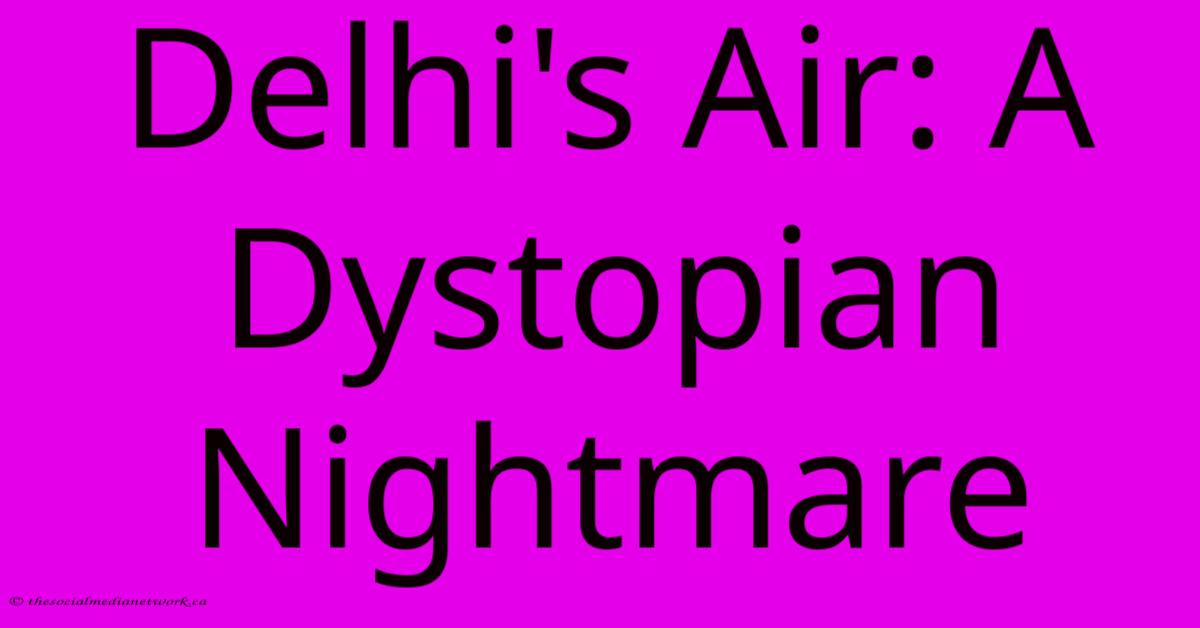Delhi's Air: A Dystopian Nightmare

Discover more detailed and exciting information on our website. Click the link below to start your adventure: Visit Best Website meltwatermedia.ca. Don't miss out!
Table of Contents
Delhi's Air: A Dystopian Nightmare
Delhi, a city of vibrant culture and historical significance, is increasingly grappling with a severe environmental crisis: air pollution. The air quality has deteriorated to such an extent that it's not just impacting the health of its residents but threatening to transform the city into a dystopian nightmare. This article delves into the grim reality of Delhi's air pollution, exploring its causes, consequences, and potential solutions.
The Smog-Choked Metropolis: Causes of Delhi's Air Pollution
The toxic smog that blankets Delhi is a complex cocktail of pollutants, stemming from various sources. Identifying these sources is the first step towards finding effective solutions.
1. Vehicular Emissions: A Major Contributor
The sheer volume of vehicles on Delhi's roads contributes significantly to the pollution. Thousands of vehicles, including cars, buses, and two-wheelers, emit harmful pollutants like nitrogen oxides (NOx) and particulate matter (PM2.5 and PM10). The ageing vehicle fleet and inadequate public transport further exacerbate the problem. Poor fuel quality also plays a role, as vehicles burning substandard fuel release more pollutants.
2. Industrial Emissions: A Silent Killer
Industrial units located within and around Delhi release a substantial amount of pollutants into the atmosphere. These include factories, power plants, and construction sites, all emitting sulfur dioxide (SO2), PM2.5, and other harmful substances. Lack of stringent enforcement of emission standards allows many industries to operate without adequate pollution control measures.
3. Construction Dust: A Growing Concern
Rapid urbanization and construction activities contribute significantly to the rising dust levels. Construction sites often lack adequate dust mitigation measures, leading to the release of fine particulate matter into the air. This dust is easily inhaled, causing serious respiratory problems.
4. Agricultural Burning: A Seasonal Menace
The practice of stubble burning in the neighboring states of Punjab and Haryana during the harvest season contributes significantly to the worsening air quality in Delhi. This practice releases massive amounts of PM2.5 and other pollutants, often leading to severe smog episodes.
5. Weather Patterns: Exacerbating the Problem
Meteorological conditions play a crucial role in trapping pollutants. During the winter months, temperature inversions and calm winds trap pollutants near the ground, leading to a build-up of smog and a dramatic decrease in air quality.
The Devastating Consequences: Health and Economic Impacts
The consequences of Delhi's air pollution are far-reaching and devastating, impacting both the health of its residents and the city's economy.
1. Respiratory Illnesses: A Public Health Emergency
Exposure to polluted air significantly increases the risk of respiratory illnesses like asthma, bronchitis, and lung cancer. Children and the elderly are particularly vulnerable to the harmful effects of air pollution. Increased hospital admissions and mortality rates associated with respiratory diseases are a clear indication of the severity of the problem.
2. Cardiovascular Diseases: A Silent Threat
Air pollution doesn't just affect the lungs; it also impacts the cardiovascular system. Studies have linked long-term exposure to air pollution with an increased risk of heart attacks, strokes, and other cardiovascular diseases.
3. Reduced Visibility and Traffic Disruptions: Economic Losses
The dense smog caused by air pollution reduces visibility, leading to traffic accidents and disruptions. This has significant economic consequences, impacting businesses, tourism, and overall productivity.
4. Environmental Degradation: A Broader Impact
Air pollution affects not only human health but also the environment. It damages vegetation, reduces crop yields, and negatively impacts the overall ecological balance of the region.
Towards a Cleaner Future: Potential Solutions
Addressing Delhi's air pollution crisis requires a multifaceted approach involving government intervention, technological advancements, and a change in public behavior.
1. Stricter Emission Norms and Enforcement
The government needs to enforce stricter emission norms for vehicles and industries. Regular inspections and penalties for non-compliance are crucial. Promoting the use of cleaner fuels and technologies is also essential.
2. Investing in Public Transportation: A Sustainable Solution
Improving public transportation systems, including expanding metro networks and improving bus services, is vital to reduce reliance on private vehicles. Making public transport more efficient and affordable can significantly reduce vehicular emissions.
3. Promoting Cycling and Walking: Healthy Habits
Encouraging cycling and walking as modes of transportation can contribute significantly to reducing air pollution. Creating dedicated cycle lanes and pedestrian walkways can make these options safer and more appealing.
4. Addressing Agricultural Burning: Collaboration is Key
Collaboration with neighboring states to find sustainable alternatives to stubble burning is crucial. Promoting techniques like in-situ management and promoting crop diversification can help reduce agricultural burning.
5. Raising Public Awareness: Collective Responsibility
Raising public awareness about the health risks associated with air pollution is crucial. Educating citizens about the importance of adopting sustainable practices and demanding cleaner air can create a powerful collective movement.
Delhi's fight against air pollution is a battle for its future. Addressing this crisis demands a concerted effort from the government, industries, and individuals. Only through a combination of stringent regulations, technological advancements, and a collective commitment to cleaner practices can Delhi hope to escape its dystopian nightmare and reclaim its vibrant, healthy future.

Thank you for visiting our website wich cover about Delhi's Air: A Dystopian Nightmare. We hope the information provided has been useful to you. Feel free to contact us if you have any questions or need further assistance. See you next time and dont miss to bookmark.
Featured Posts
-
Outlook And Microsoft 365 Service Disruption
Nov 26, 2024
-
Dimension Market Research E And P Software Market
Nov 26, 2024
-
William And Mary Vs Monarchs Tuesday Game
Nov 26, 2024
-
Loving The New Champions League Format
Nov 26, 2024
-
Charli Xcx Concert Ticket Prices 2025
Nov 26, 2024
